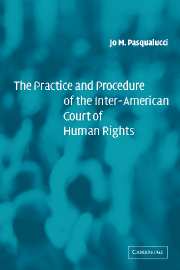Book contents
- Frontmatter
- Contents
- Foreword
- Preface
- Acknowledgments
- Table of cases
- Table of Articles of the American Convention on Human Rights
- Table of 2001 Rules of Procedure of the Inter-American Court on Human Rights
- Table of 2001 Rules of Procedure of the Inter-American Commission on Human Rights
- Table of other legal instruments and documents
- 1 Introduction
- PART I The advisory jurisdiction of the Inter-American Court
- PART II The contentious jurisdiction of the Inter-American Court of Human Rights
- PART III Provisional measures
- 6 Provisional measures:
- 7 Conclusion: the effectiveness of the Inter-American Court
- Appendix 1 American Convention on Human Rights
- Appendix 2 Rules of Procedure of the Inter-American Court of Human Rights
- Appendix 3 Statute of the Inter-American Court of Human Rights
- Appendix 4 Rules of Procedure of the Inter-American Commission on Human Rights
- Appendix 5 Form for presenting petitions on human rights violations
- Bibliography
- Index
7 - Conclusion: the effectiveness of the Inter-American Court
Published online by Cambridge University Press: 28 July 2009
- Frontmatter
- Contents
- Foreword
- Preface
- Acknowledgments
- Table of cases
- Table of Articles of the American Convention on Human Rights
- Table of 2001 Rules of Procedure of the Inter-American Court on Human Rights
- Table of 2001 Rules of Procedure of the Inter-American Commission on Human Rights
- Table of other legal instruments and documents
- 1 Introduction
- PART I The advisory jurisdiction of the Inter-American Court
- PART II The contentious jurisdiction of the Inter-American Court of Human Rights
- PART III Provisional measures
- 6 Provisional measures:
- 7 Conclusion: the effectiveness of the Inter-American Court
- Appendix 1 American Convention on Human Rights
- Appendix 2 Rules of Procedure of the Inter-American Court of Human Rights
- Appendix 3 Statute of the Inter-American Court of Human Rights
- Appendix 4 Rules of Procedure of the Inter-American Commission on Human Rights
- Appendix 5 Form for presenting petitions on human rights violations
- Bibliography
- Index
Summary
Compliance and non-compliance by states with their international obligations depends less on the formal status of a judgment and its abstract enforceability. Much more important is its impact as a force capable of legitimating governmental conduct and the perception of governments about the political cost of non-compliance.
The effect of the Inter-American Court on the emergence of international human rights law
The judgments and opinions rendered by the Inter-American Court have significantly contributed to the development of international human rights law and to its doctrinal divergence from traditional international law. International human rights law principally developed following the atrocities of the Second World War. Even then, acceptance of the discipline was gradual. As late as the 1960s, influential members of the American Society of International Law argued that human rights was not a part of international law. Sohn describes the advent of human rights law as a ‘revolution’. He writes that:
[j]ust as the French Revolution ended the divine rights of kings, the human rights revolution that began at the 1945 San Francisco Conference of the United Nations has deprived the sovereign states of the lordly privilege of being the sole possessors of rights under international law. States have had to concede to ordinary human beings the status of subjects of international law, to concede that individuals are no longer mere objects, mere pawns in the hands of states.
- Type
- Chapter
- Information
- Publisher: Cambridge University PressPrint publication year: 2003



